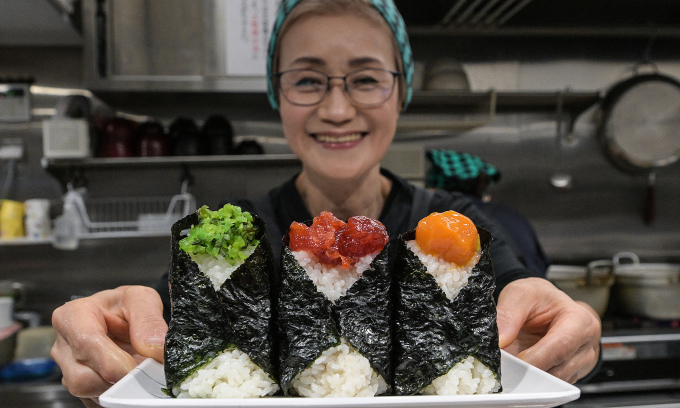[ad_1]
Mouth-watering photos on social media, rising demand for reasonably priced lunches, and a surge in tourism to Japan are all drawing folks to the common-or-garden onigiri.
Simply ask any of the 50-odd clients lined up in a quiet nook of Tokyo for the restaurant Onigiri Bongo to open.
Prior to now, “nobody got here between lunch and dinner, however now clients queue continuous”, stated 71-year-old Yumiko Ukon, who runs the greater than half-century-old store.
Some anticipate eight hours, stated Ukon, whose crew makes some 60 various kinds of onigiri, bulging with conventional fillings like pickled plum, or extra uncommon choices similar to bacon with soy sauce.
Onigiri Bongo solely has 9 counter seats, however sells round 1,200 rice balls every day.
 |
|
This photograph taken on Dec. 7, 2023 reveals Yumiko Ukon, who runs the restaurant Onigiri Bongo, a store specializing in rice balls generally known as “onigiri”, posing with rice balls she made within the Otsuka space of Tokyo. Picture by AFP |
“After I was younger, onigiri was one thing you’ll make at dwelling,” Ukon informed AFP. “Now folks purchase onigiri, or exit to have onigiri.”
Lengthy widespread as on-the-go gasoline in Japan, onigiri have been eaten for over a millennium within the nation, the place they have been as soon as taken onto the battlefield by samurai.
The fast bites might be present in comfort shops on virtually each nook, ubiquitous sufficient to be banal.
However with extra guests than ever flocking to Japan, and the nation’s popular culture booming in recognition, onigiri at the moment are additionally changing into a lunch choice abroad.
Japanese rice ball chain Omusubi Gonbei has opened shops in Paris and close to Grand Central Station in New York.
“It is gentle, wholesome and simple to eat,” stated 53-year-old buyer Sean King, who first tried onigiri in Japan and was “very glad” to search out them within the Huge Apple.
“You have no regrets after consuming one.”
Inexpensive lunch
The oldest rice ball restaurant in Tokyo, Onigiri Asakusa Yadoroku, was included within the 2019 Michelin Information, elevating the standing of the snack.
“From that second, individuals who noticed onigiri as an on a regular basis chew to eat started to see it as a top quality dish,” stated Yusuke Nakamura, president of Japan’s Onigiri Society.
Spending on onigiri and different pre-prepared rice merchandise has grown by 66 p.c over the previous 20 years in Japan, figures from the inner affairs ministry present.
In 2022, onigiri have been the second-most-frequently bought ready-to-eat meals in Japan after bento lunchboxes, in keeping with the Japan Prepared-made Meal Affiliation.
And the variety of specialised onigiri retailers is rising shortly, Nakamura stated.
 |
|
a employees member carrying a show of rice balls at Taro Tokyo Onigiri, a store specializing in Japanese rice balls, generally known as “onigiri”, with stylish fillings and toppings, at certainly one of their shops in Tokyo, December 2023. Picture by AFP |
The pattern has been pushed by demand for takeaway meals in the course of the pandemic, but additionally inflation, with folks selecting onigiri over a restaurant meal to save cash.
Whereas imported grains like wheat have grow to be costlier due to the battle in Ukraine, “the value of rice, grown domestically, is comparatively secure”, Nakamura defined.
Japanese folks have deep cultural hyperlinks to rice, stated Miki Yamada, who runs “Warai Musubi”, a catering service specializing in “omusubi” — one other identify for onigiri.
Within the Shinto faith, “rice is an providing made to deities”, and the standard triangular form of onigiri could also be a reference to mountains, the place many Shinto gods dwell, the 48-year-old stated.
‘Premium’ rice balls
Yamada, whose household are rice farmers in Fukushima, realized the potential of onigiri after pondering up methods to advertise rice from the area after the 2011 nuclear catastrophe.
She started posting photos of her completely offered rice balls on social media, and the enterprise grew from there.
Onigiri retailers normally cannot afford promoting, however on-line posts by followers exhibiting completely different sorts of the colourful dish have performed an enormous function of their new recognition, the Onigiri Society’s Nakamura stated.
Youthful clients are additionally attracted by “premium” rice balls made with high quality elements, with numerous different cereals blended in to make them extra nutritious.
Miyuki Kawarada, 27, is president of Taro Tokyo Onigiri, which opened two retailers within the capital in 2022 promoting top-quality onigiri at as much as 430 yen ($2.85) every.
Kawarada needs to open dozens of onigiri eating places overseas and thinks the snack might sooner or later dethrone sushi as Japan’s best-known culinary export.
Onigiri “might be vegan, or halal, and might be tailored to go well with completely different cultures”, she informed AFP.
“In Japan, but additionally overseas, I need to renew the stuffy, old school picture of rice.”



